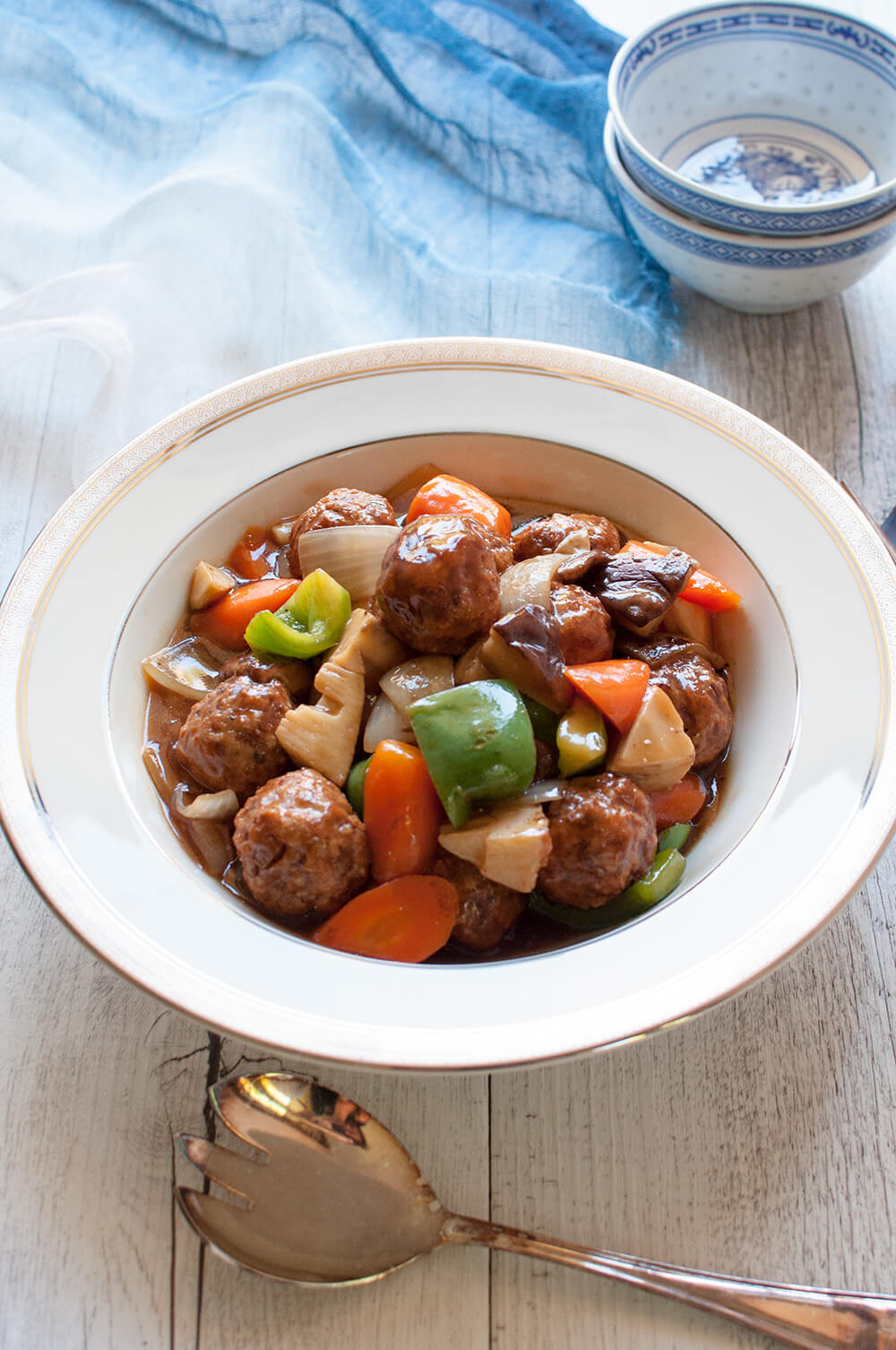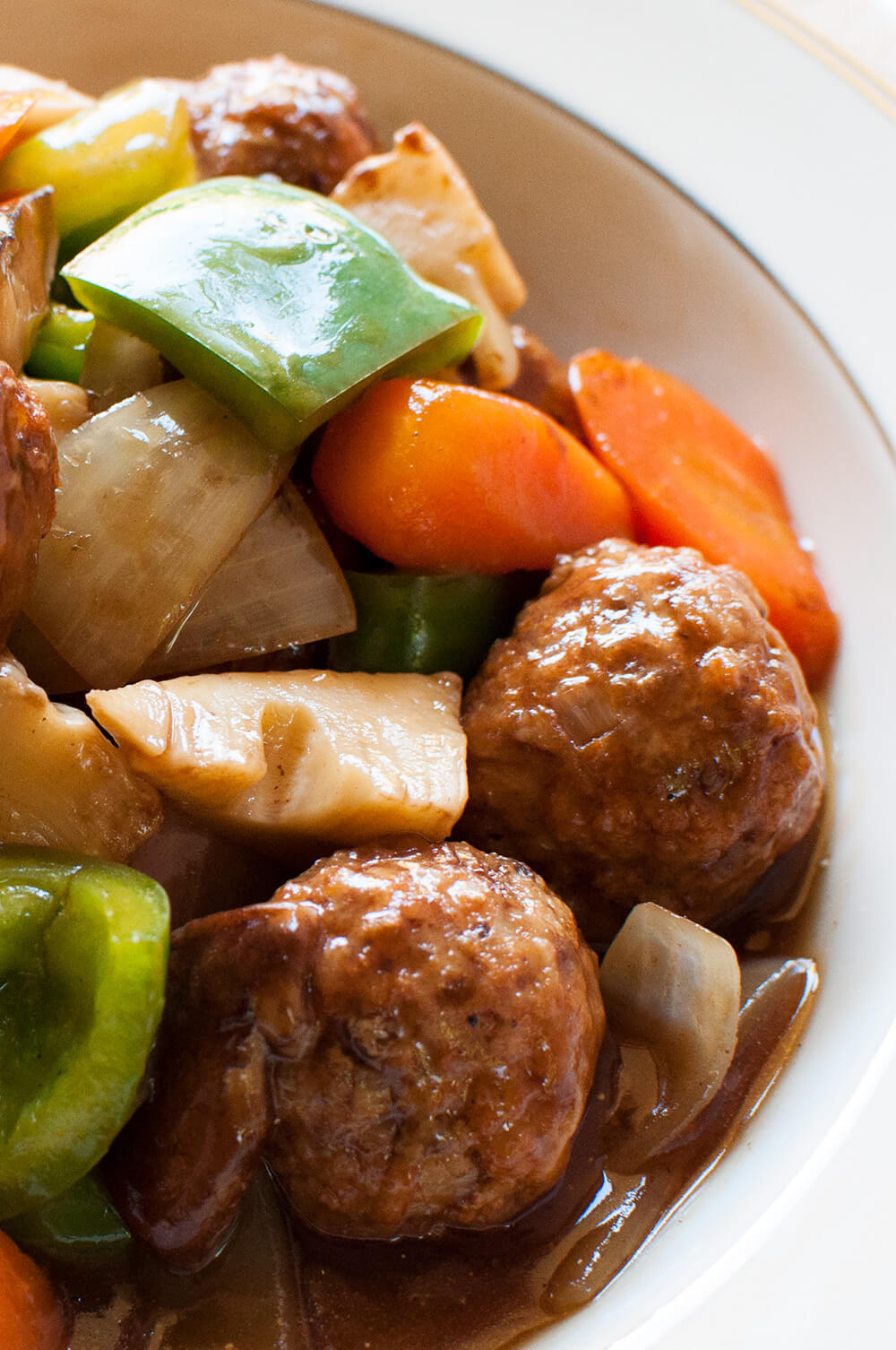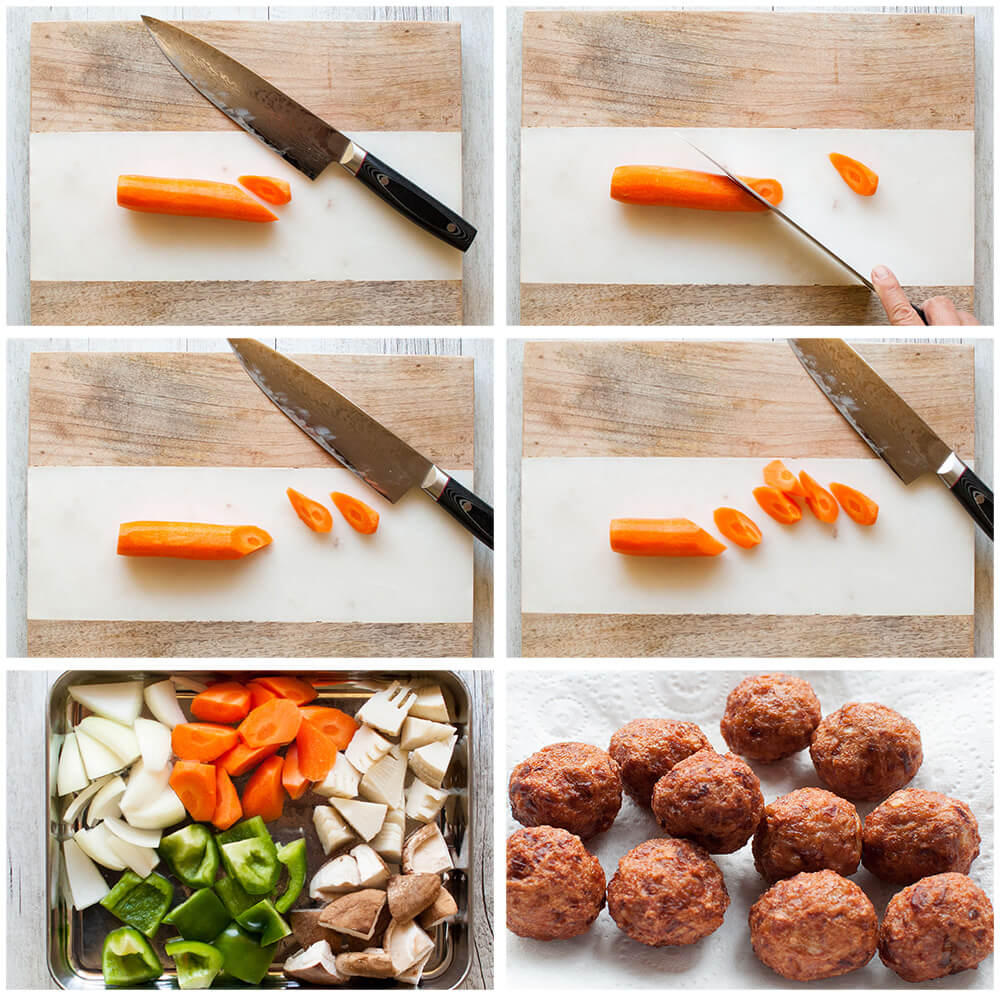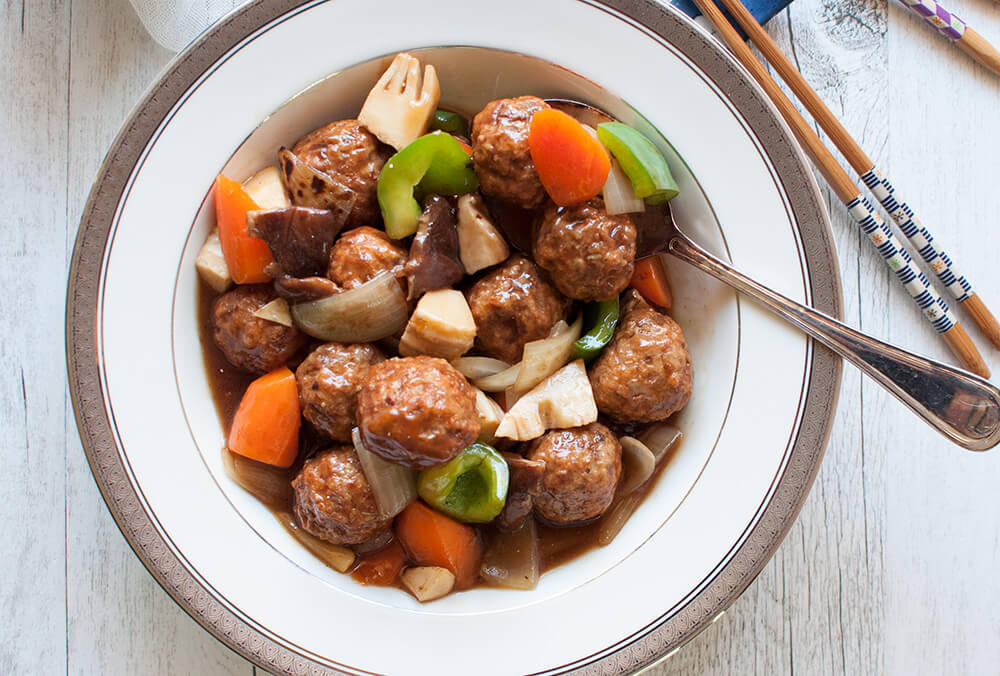Sweet and sour pork usually uses cubed pork but this is a meatball version of sweet and sour pork. Onions in the meatballs give the meat more flavour and the sauce is not as strong as original Chinese sweet and sour pork.

I posted Japanese Pork Meatballs (Niku-dango) with Two Sauces last week. I had plenty of them left over, so I decided to make sweet and sour pork using these meatballs. The only difference from the usual sweet and sour pork is the meat. You can use cubed pork instead to make it a standard sweet and sour pork dish.
In Japan, it is called subuta (酢豚) which means vinegar pork. It is a Chinese dish, as you all know, but my version is not as oily and the flavour is not very strong. It is a kind of Japanese version of sweet and sour pork.
The original sweet and sour pork uses deep fried cubed pork. And the vegetables are also deep fried. Vegetables like green capsicum will retain their bright colours by deep frying first. I once made a Chinese style dish by deep frying not only the pork cubes but also vegetables. But the dish was a bit too heavy for me.
When I was still working in the city, I occasionally went to a Chinese restaurant with my colleagues or my team members. Sweet and sour pork was one of the dishes people liked. It might be that the flavour of the dish was adjusted to suit to Australian people but I found that the flavour was too sweet and strong. It must be my Japanese palette.

The major differences in my recipe from the Chinese sweet and sour pork are:
- Vegetables are not deep fried
- No spices
- Add chicken stock
- No pineapples
Sweet and sour pork often contains pineapples and I remember telling myself, “What the hell is this? Pineapple in this dish?”. You see, I never had it with pineapples when I was in Japan. It wasn’t common back then. But I know that some Japanese people do add pineapple these days.
Come to think of it, I don’t fancy cooked fruits to go with meat very much. For example, apple sauce on pork and cranberry sauce on turkey are not my best friend. I can eat the dish but I won’t go “wow”. I find that the dish becomes too sweet and I’d rather eat the meat without the sauce.
The vegetables almost always included in sweet and sour pork are onion and capsicum. Both green and red capsicums are often used to add more colours to the dish. In the case of subuta, carrots are often added to the dish just like today’s recipe.
I used a roll cutting method to cut the carrots. It is called rangiri (乱切り) in Japanese, meaning random cut. Place a whole carrot on the cutting board and cut the carrot straight down with a diagonal angle. Then roll the carrot 90 degrees, facing the freshly cut surface up. Place the blade on the cut surface at the same diagonal angle, then cut down. Repeat all way along the length of the carrot.

This cutting method is suitable for thin, long vegetables. In Japan, rangiri is used for simmered dishes as it creates more surface area on the vegetables. I also think that rangiri vegetables present more interesting shapes than sliced or cubed vegetables.
I had left-over boiled bamboo shoots in the fridge so I added them along with shiitake mushrooms. But you don’t need to use them and you can also add other vegetables such as zucchini, shallots (scallions), baby corn, etc. I think that the dish will look more appetising with different colours of vegetables, especially as the sauce is brown.
As you can see in the recipe, if you already have meatballs in the fridge or freezer, it will take no more than 15 minutes to make it.
Yumiko![]()


Sweet and sour pork usually uses cubed pork but this is a meatball version of sweet and sour pork. Onions in the meatballs give the meat more flavour and the sauce is not as strong as original Chinese sweet and sour pork.
Prep Time and Cook Time do not include the time to make pork meatballs.
- ½ quantity of cooked meatballs used in the recipe Japanese Pork Meatballs with Two Sauces (note 1), hot or room temperature
- 80 g (2.8oz) carrot, roll cut to 4cm (1½”) lengths (note 2)
- 80 g (2.8oz) capsicum, cut into 3cm (1¼“) cubes
- 80 g (2.8oz) boiled bamboo shoot, cut into 3cm (1¼“) wedges (note 3)
- ½ onion , cut half horizontally, then wedges
- 3 shiitake mushrooms (note 4), cut into quarter
- 1 tbsp vegetable oil
-
Boil carrots until just cooked through and drain.
-
Put all the Sweet and Sour Sauce ingredients, except sesame oil, in a bowl and mix well.
-
Heat oil in a wok or a large fry pan over medium-high heat.
-
Add all the vegetables and stir fry until the edge and surface of the vegetables are slightly burnt – about 2-3 minutes.
-
Add meatballs and stir for about 1 minute. Then add the sauce mixture. As the sauce heats up, it will get thicker.
-
When the sauce starts boiling, add sesame oil, mix and turn the heat off.
-
Serve immediately.
1. It uses 250g (8.8oz) of pork mince (ground pork) if you follow the recipe, Japanese Meatballs (Niku Dango) with Two Sauces. Frozen meatballs can be used but you would need to thaw them and bring to the room temperature before cooking.
2. It is called rangiri (乱切り) in Japanese, meaning random cut.
a. Place a whole carrot on the cutting board and cut the carrot straight down with a diagonal angle.
b. Then roll the carrot 90 degrees, facing the cut surface up.
c. Place the blade in the middle of the cut surface at the same diagonal angle, then cut down.
d. Repeat all way along the length of the carrot.
By changing the angle, you can make short or long pieces. Also see the photos in the blog.
3. You can buy boiled bamboo shoots in a vacuum sealed bag or a tin at Japanese/Asian grocery stores. You can also substitute for different vegetables or omit this and increase the quantity of other vegetable ingredients.
4. My shitake was about 30g (1oz) in total, 6 cm (2⅜”) in diameter. Depending on the size of each mushroom, you would need to cut into smaller/larger pieces.
5. It is important to cut the vegetables almost into similar sizes.
Thank you for sharing! This is my husband’s favorite dish.
Hi Hayasaka, you are most welcome!
I’m confused. Are the meatballs deep fried first, or are they cooked through with the vegetables? The cooking time fore the vegetables doesn’t seem to be enough to cook the meatballs throughly.
Hi Yvonne, It is meant to use the already deep fried meatballs cooked per the previous week’s post, Japanese Meatballs (Niku Dango) with Two Sauces. I will add a note. Thanks for asking!
You can buy the meatball already cooked or you can make it with pork hamberger table spoon the amount on then roll in a ball then fry or put them on a baken sheet in the oven at 325 till cooked
Good morning yumiko, This looks good. I agree w/ you on some of the Chinese foods are too sweet like this one . I’m not to crazy of sweet dishes unless its a dessert. . I love Japanese, korean, Vietnamese and Thai foods . I tend to cook spicier foods than others. I’m not affraid to try any ethnic foods because thats how you learn the cultures . The things i like about you and Nagi is I’m learning some Japanese words. thank you and keep cooking !!!!!!
It’s great to be able to try almost any kind of cuisine, isn’t it? Great to know that you share the similar view on flavours. Thanks!